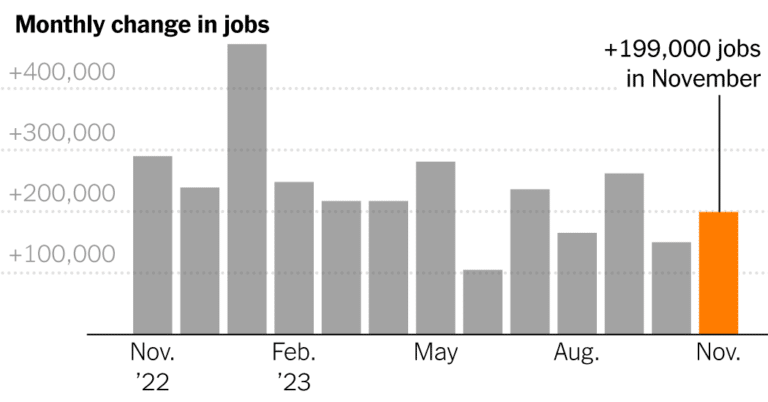The economy continued to generate robust job growth in November, suggesting there is still juice left in a labor market that has been slowing almost imperceptibly since last year’s pandemic rebound.
Employers added 199,000 jobs last month, the Labor Department reported Friday, while the unemployment rate dropped to 3.7 percent. The increase in employment includes approximately 41,000 autoworkers and actors who returned to their jobs after strikes, and others in related businesses that had been stalled by the walkouts.
The number is the latest sign that the American economy remains far from recession territory despite a year and a half of interest rate increases that have weighed on consumer spending and business investment. Reinforcing the picture of energetic labor demand, wages jumped 0.4 percent over the month, more than expected, and the workweek lengthened slightly.
Most analysts have been surprised by the durability of the recovery, which owes a lot to the cash that consumers accumulated over the past few years. That has powered service-industry jobs even in the face of rising costs, the resumption of mandatory student debt payments and slowing wage growth.
“That’s the definition of a soft landing: It’s slowing slowly, which is what you want,” said Martin Holdrich, a senior economist with Woods & Poole Economics. He noted, however, that with strong productivity growth, the enduring tightness of the labor market needn’t prompt the Federal Reserve to continue increasing interest rates.
“These numbers do not indicate an overheated economy and shortages that will drive up inflation,” Mr. Holdrich said.
November’s growth was essentially in line with the last few months, accounting for strike activity, though a step down from the 240,000 jobs added per month on average over the year ended in October. During the survey window, there were still approximately 10,000 workers still on strike at workplaces including casinos and hospitals.
Job growth has narrowed in recent months, with sectors dependent on consumers buying physical goods declining and service industries accounting for most gains. In November, health care added 77,000 jobs and government added 49,000 — both employers that are less tethered to the underlying strength of the economy.
Manufacturers added back the jobs lost during the auto strikes but have otherwise been stagnant since the beginning of the year. The retail industry shed 38,000 jobs on a seasonally adjusted basis, reflecting what appears to be the weakest holiday hiring season since 2013.
Temporary help services, often considered a bellwether for labor demand, shed 14,000 jobs, an indication that employers aren’t trying to meet surges in business with contingent workers. That industry has lost 177,000 since last November.
The trajectory for most of 2023 has pointed toward exactly the sort of soft landing that the Fed is seeking with its interest rate policy: a historically high number of job openings has steadily receded, initially without a significant rise in the unemployment rate.
Even as some industries that surged during the pandemic have shed jobs, others that struggled to win workers back during the recovery — such as hotels and restaurants — soaked up labor from contracting businesses, helping to stave off a rise in joblessness.
“If you have a sector like wholesale or retail trade start to shed workers they can very easily transition into something like leisure and hospitality,” said Michael Reid, a U.S. economist at RBC Capital Markets. “If those sectors start to see a pullback in spending, we still do see strength in health care and social assistance.”
The picture has started to change in recent months, however, with the unemployment rate rising to 3.9 percent in October as a result of both permanent layoffs and more people entering the labor force in search of work.
The share of people over 55 who are in the labor force — working or looking for work — dropped in 2020 and hasn’t recovered, but those between the ages of 25 and 54 have rushed back. It has become increasingly apparent that women in that age bracket, who achieved a record level of participation this year, have benefited from the broader availability of remote work.
That influx of workers — which includes a recovery in immigration flows — has also taken the air out of wage increases. Combined with a surge in productivity, that means current levels of pay growth may be consistent with the Federal Reserve’s inflation goal of 2 percent annually. The annual inflation rate has recently fallen to 3 percent, less than half what it was when the Fed’s interest rate increases began.
Despite the stronger-for-longer performance of the labor market thus far, most forecasters expect a continued decline in job growth in early 2024 as consumers run through their savings, reducing spending, and the remaining pockets of labor shortage fill up.


